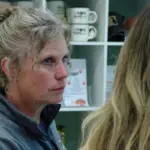Habitat for Humanity’s ReStore Brings Discounts to Westminster and Funds for Homebuilding Projects
by Linda L. Esterson – photography by Nikola Tzenov
The old saying “One man’s trash is another man’s treasure” could have been penned specifically for Carroll County’s newest bargain shopping warehouse. The Habitat for Humanity of Carroll County ReStore opened in March, providing deal hunters access to the latest concept in thrift shopping.
The second-largest and newest of Maryland’s ReStores, the Westminster store collects donations of new and gently used furniture, appliances, home accessories and building materials and sells them at great discounts to the public. Unlike other thrift operations that support large salaried executives, ReStore’s proceeds fund the local organization’s efforts to construct and rehabilitate housing for needy families in the area in conjunction with Habitat for Humanity’s overall global mission to build homes, communities and hope. Since its inception in 2001, Habitat for Humanity of Carroll County has built or rehabilitated nine homes, shaping the future for families that include 21 children.
The 25,000-square-foot store, located in the former Westminster Antique Mall on Hahn Road, was designed to be a Carroll County destination, with easy access from the south, north and even over the border from Pennsylvania, says Chris Abell, store manager. The space provides ample room to accept and categorize donations, coordinate testing and repairs for electrical items and appliances, and perform minor repairs to furnishings. There’s also a truck, manned by a full-time driver, to pick up large donations at no cost to the Carroll Countian making the donation.
The store also enables atypical donations for Habitat for Humanity. Beyond writing a check, item donations can help members of the community and the environment at large. “We’re an alternative donation arm for Habitat for Humanity,” Abell explains. “Not everyone can donate money. Here you can donate to Habitat by donating your gently used furniture, which we can resell and keep it out of the landfill. You can donate by buying some furniture from us. And you can volunteer your time.
“It’s a way for someone to get involved with Habitat for Humanity in a different fashion. If you don’t want to do a house-build, or if we don’t have a house-build going, or if they don’t have means to financially contribute, they can always donate items or buy items and support our secondary mission of keeping things out of the landfill.”

Customers enter the ReStore lobby to a spacious showroom of decorated living room and dining room areas. On a mid-August morning, the showroom featured a dark wood dining table with coordinating white wood chairs, staged with bone-colored china and beveled glassware, a multicolored antique-looking rug and blue-tinted vase with dried pussy willow branches. There was also a living room with a dark leather recliner sofa, dark wood coffee and end tables, and a glass and wood entertainment unit that spanned from floor to ceiling. An elegant dark wood grandfather clock hugged the corner, and rounding out the room were bedroom sets, individual entertainment centers and china cabinets in an assortment of materials and colors.
Beyond the showroom, the store is well organized by item type. More china cabinets, some with china sets, lined the walls, and the center housed nearly 100 sofas, loveseats and chairs of varying fabrics and sizes. There’s a “Ravens room” with purple couch and loveseat, and compatible entertainment center, coffee table and even football-themed glassware. Further into the warehouse sit hundreds of additional furniture pieces including dressers, desks, table and chair sets, bed frames and more.
On any given day, as many as 300-400 shoppers spend hours perusing these areas as well as the warehouse, which holds home appliances, building materials, tools, unused donated paint (direct from a supplier), plumbing supplies and glassware. The most popular area is one that few would guess — the book and media nook, where CDs, DVDs and books line shelving units that span the full height of the building. Each item there sells for just $1. This day’s find included individual copies of Pretty Little Liars novels and full seasons of One Tree Hill.
According to Abell, pricing is a meticulous process. Donated items are researched using online discount and retail sites to determine their value. The ReStore price is usually about 50 percent less. But that’s just the start. If an item remains on the floor for two weeks, it’s then further discounted by 25 percent. After two more weeks, it’s reduced to 50 percent of the original ReStore price, and after six weeks, the price is reduced by 75 percent. A colored sticker system enables shoppers to determine the item’s discount on any day, and if it remains in stock after six weeks, the price drops and the cycle repeats.
The beauty of ReStore is not just its pricing structure. It’s about the treasures people find. With newly donated items arriving daily, customers find “steals” they hadn’t seen the day before. Occasionally, an item is mispriced, always to the customer’s benefit. It can be an antique that went through unnoticed or a showerhead for $15 that retails for $200. There’s also a large custom window, priced up to $5,000 retail, that is on the floor for $1,200.
“A lot of people want to treasure-hunt,” Abell said. “We always have new stuff. They want to find the valuable things we didn’t catch.”
Westminster faux finish artist Jutz Moreland visits ReStore a few times each month — she intentionally limits her visits to keep herself on budget — for bargains on dishes, desks and dressers. She recently purchased a tapestry for a dollar and she’s even converted a few purchased heirlooms into sinks.
“To most people it looks like junk,” she says of some of the older pieces that appear worn or out of style. “To me, it’s a diamond in the rough. It has potential. I can see what it can be, not what it is.”
Hampstead’s Susan Block shared her excitement for her first visit to ReStore as she perused a set of delicate flowered china. “I always buy donated items,” she said. “I think it’s a good cause. I believe in recycling.
“It’s a good way to help the community, a good way to share and give back.”
The ReStore runs with up to six full-time employees, based on the organization’s homebuilding needs, and the help of a core of volunteers, who do everything from stocking, pricing, repairing and testing of products. A volunteer board of directors provides governorship.
The organization relies also on its financial sponsors, including the Kahlert Foundation, which contributed $150,000, and others like State Farm, Our Heavenly Cause Foundation and many more. The organization also depends on its successful community partnerships with companies that donate products that help outfit the store or are sold to the public, like Random House, Lowe’s, Target and Mercer Carpet One. Additional retail partners are welcome.
Mercer donates flooring, sometimes installing at the ReStore or in the homes being built. According to Mercer’s president, Jim Farrell, a truck carries excess flooring or carpeting to ReStore every two months. The products, at an estimated $15,000 to $20,000 value each year, could be sold by Mercer to other customers within a year. Instead, Farrell opts to donate it to ReStore.
“It’s a good alternative to other places that are similar to it,” Farrell says. “You know specifically where the money is going to go from the store. It’s going to build a house or rehab a house.”
ReStore also works closely with BERC, the county’s business employment resource center. ReStore’s construction included the creation of a classroom/training center developed in conjunction with BERC. The organization sends volunteers to work at ReStore, which in turn provides workforce training.
Abell said that, with the store open for less than a year, there’s still growth expected. He hopes to add community events like inviting Santa Claus for photo opportunities, hosting small-scale concerts or even having a “Trunk or Treat” event around Halloween. He’d also like to host classes for the community on furniture restoration and refinishing.
“We already do a good job in engaging the community from a retail sales perspective, and everyone who works here and volunteers from the community,” he said. “I still think there’s an opportunity to do more for the community.
“We’re just starting,” he said. “This is just the beginning of what we are.”













